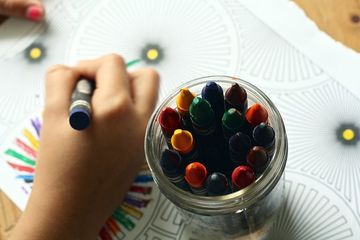We found 54 results that contain "adhd students"
Posted on: #iteachmsu

ASSESSING LEARNING
Disease Control and Prevention study
ADHD is one of the most commonly diagnosed conditions of children (Centers for DiseaseControl and Prevention, 2015).
In a 2016 Centers for Disease Control and Prevention study, scientists found that 6.1 million children aged 2-17 years living in the U.S. had been diagnosed with attention-deficit/hyperactivity disorder (ADHD), which is similar to previous en
Ages 6-11: Approximately 2.4 million children
Ages 12-17: Approximately 3.3 million children
The diagnostic term attention deficit/hyperactivity disorder (ADHD) refers to individuals who display patterns of inattention, impulsivity, and overactive behavior that interfere with daily functioning (American Psychiatric Association [APA], 2013).
The Diagnostic and Statistical Manual (DSM) V (APA, 2013) criteria for diagnosing ADHD listthree types of ADHD and the accompanying characteristics
Ref :
In a 2016 Centers for Disease Control and Prevention study, scientists found that 6.1 million children aged 2-17 years living in the U.S. had been diagnosed with attention-deficit/hyperactivity disorder (ADHD), which is similar to previous en
Ages 6-11: Approximately 2.4 million children
Ages 12-17: Approximately 3.3 million children
The diagnostic term attention deficit/hyperactivity disorder (ADHD) refers to individuals who display patterns of inattention, impulsivity, and overactive behavior that interfere with daily functioning (American Psychiatric Association [APA], 2013).
The Diagnostic and Statistical Manual (DSM) V (APA, 2013) criteria for diagnosing ADHD listthree types of ADHD and the accompanying characteristics
Ref :
Authored by:
William

Posted on: #iteachmsu


Disease Control and Prevention study
ADHD is one of the most commonly diagnosed conditions of children (...
Authored by:
ASSESSING LEARNING
Wednesday, Dec 23, 2020
Posted on: #iteachmsu

NAVIGATING CONTEXT
What is Attention Deficit Hyperactivity Disorder?
ADHD is one of the most commonly diagnosed conditions of children (Centers for DiseaseControl and Prevention, 2015).
In a 2016 Centers for Disease Control and Prevention study, scientists found that 6.1 million children aged 2-17 years living in the U.S. had been diagnosed with attention-deficit/hyperactivity disorder (ADHD), which is similar to previous en
Ages 6-11: Approximately 2.4 million children
Ages 12-17: Approximately 3.3 million children
The diagnostic term attention deficit/hyperactivity disorder (ADHD) refers to individuals who display patterns of inattention, impulsivity, and overactive behavior that interfere with daily functioning (American Psychiatric Association [APA], 2013).
The Diagnostic and Statistical Manual (DSM) V (APA, 2013) criteria for diagnosing ADHD listthree types of ADHD and the accompanying characteristics.
In a 2016 Centers for Disease Control and Prevention study, scientists found that 6.1 million children aged 2-17 years living in the U.S. had been diagnosed with attention-deficit/hyperactivity disorder (ADHD), which is similar to previous en
Ages 6-11: Approximately 2.4 million children
Ages 12-17: Approximately 3.3 million children
The diagnostic term attention deficit/hyperactivity disorder (ADHD) refers to individuals who display patterns of inattention, impulsivity, and overactive behavior that interfere with daily functioning (American Psychiatric Association [APA], 2013).
The Diagnostic and Statistical Manual (DSM) V (APA, 2013) criteria for diagnosing ADHD listthree types of ADHD and the accompanying characteristics.
Authored by:
Primer text from The College of William & Mary

Posted on: #iteachmsu


What is Attention Deficit Hyperactivity Disorder?
ADHD is one of the most commonly diagnosed conditions of children (...
Authored by:
NAVIGATING CONTEXT
Thursday, Nov 30, 2023
Posted on: #iteachmsu

DISCIPLINARY CONTENT
Cooperative Learning
Carefully structured cooperative learning groups in which each student is assigned a role and has clear expectations for desired outcomes are very helpful for students with ADHD. The more structured the cooperative activity, the more likely it is that these students will succeed.
Posted by:
Chathuri Super admin..

Posted on: #iteachmsu


Cooperative Learning
Carefully structured cooperative learning groups in which each stud...
Posted by:
DISCIPLINARY CONTENT
Monday, Sep 14, 2020
Posted on: #iteachmsu

DISCIPLINARY CONTENT
Cooperative Learning
Carefully structured cooperative learning groups in which each student is assigned a role and has clear expectations for desired outcomes are very helpful for students with ADHD. The more structured the cooperative activity, the more likely it is that these students will succeed.
Authored by:
Chathu
Posted on: #iteachmsu

Cooperative Learning
Carefully structured cooperative learning groups in which each stud...
Authored by:
DISCIPLINARY CONTENT
Monday, Sep 14, 2020
Posted on: #iteachmsu

Visual and Environmental Prompts:
Use behavioral and environmental prompts to increase desired classroom behaviors. For example, pictorial prompts of students attending in class serve as a reminder of the teacher’s expectations for learning and behavior. Electronic visual aids such as interactive whiteboards and document cameras are helpful for capturing the attention of students with ADHD (Piffner, 2011).
https://www.cliffsnotes.com/study-guides/principles-of-management/the-evolution-of-management-thought/behavioral-management-theory
Additionally, the use of tablets and computers may engage students more fully in learning activities.
Priming Procedure: Prime the student before an assignment or lesson byreviewing a list of student-identified privileges or reinforcements that can beearned following a specified work period.
Proximity Control: Teacher proximity is highly effective for helping studentswith ADHD maintain attention. For example, the teacher may move closer to thestudent when giving directions and monitoring seatwork.
Timers: Set a timer to indicate how much time remains in the lesson or workperiod. The timer should be clearly visible so students can check remaining timeand monitor their progress.
Wristwatch or Smartphone: Teach the student to use a wristwatch orsmartphone to manage time when completing assigned work. Many watches andsmartphones have built-in timers that can be programmed to beep at set intervals.
Music: Play different levels and tempos of music to help students understand theactivity level appropriate for particular lessons. For example, using quiet classicalmusic for individual learning activities helps block distractions and creates a calmclassroom environment (U.S. Department of Education, 2006).
Children with ADHD require specific and frequent feedback and/or reinforcementimmediately following the demonstration of desired behaviors. When students arelearning new behaviors, it is generally important to reinforce close approximations firstas a way to shape behavior. Once a behavior is established, the frequency ofreinforcement can be gradually decreased. Students with ADHD tend to quickly loseinterest with repetition, so a variety of easy-to-implement reinforcers should beconsidered.Praise, Praise, Praise: Attentiveness and appropriate classroom behavior areprerequisites for learning; therefore, interventions that promote these behaviorsshould be an integral part of the teaching process for all students. When teachersare attentive to positive behavior and specifically praise students for thesebehaviors, they can engage students before their attention drifts while highlightingdesired behavior (U.S. Department of Education, 2006).
https://www.cliffsnotes.com/study-guides/principles-of-management/the-evolution-of-management-thought/behavioral-management-theory
Additionally, the use of tablets and computers may engage students more fully in learning activities.
Priming Procedure: Prime the student before an assignment or lesson byreviewing a list of student-identified privileges or reinforcements that can beearned following a specified work period.
Proximity Control: Teacher proximity is highly effective for helping studentswith ADHD maintain attention. For example, the teacher may move closer to thestudent when giving directions and monitoring seatwork.
Timers: Set a timer to indicate how much time remains in the lesson or workperiod. The timer should be clearly visible so students can check remaining timeand monitor their progress.
Wristwatch or Smartphone: Teach the student to use a wristwatch orsmartphone to manage time when completing assigned work. Many watches andsmartphones have built-in timers that can be programmed to beep at set intervals.
Music: Play different levels and tempos of music to help students understand theactivity level appropriate for particular lessons. For example, using quiet classicalmusic for individual learning activities helps block distractions and creates a calmclassroom environment (U.S. Department of Education, 2006).
Children with ADHD require specific and frequent feedback and/or reinforcementimmediately following the demonstration of desired behaviors. When students arelearning new behaviors, it is generally important to reinforce close approximations firstas a way to shape behavior. Once a behavior is established, the frequency ofreinforcement can be gradually decreased. Students with ADHD tend to quickly loseinterest with repetition, so a variety of easy-to-implement reinforcers should beconsidered.Praise, Praise, Praise: Attentiveness and appropriate classroom behavior areprerequisites for learning; therefore, interventions that promote these behaviorsshould be an integral part of the teaching process for all students. When teachersare attentive to positive behavior and specifically praise students for thesebehaviors, they can engage students before their attention drifts while highlightingdesired behavior (U.S. Department of Education, 2006).
Authored by:
Piffner, 2011
Posted on: #iteachmsu

Visual and Environmental Prompts:
Use behavioral and environmental prompts to increase desired classr...
Authored by:
Tuesday, Oct 13, 2020
Posted on: #iteachmsu

NAVIGATING CONTEXT
Connecting Knowledge to Action through Global Education Competency
Global Education
Global education helps students develop their capacity to be informed, open-minded, and responsible people who are responsive to diverse perspectives. Global education prepares us to address the world’s most pressing issues collaboratively, equitably, and sustainably. Global education helps students understand that pressing issues must be faced in an interdisciplinary way, given the complexity of environments and competing needs and interests.
Through global education, students will prepare to thrive and lead change in an interconnected world. Students will engage in dimensions of cultural diversity to reach common understandings and goals. Through a stronger awareness of global issues, students will be able to address today’s greatest challenges and make a difference in the world, both collaboratively and equitably.
Global education helps students develop their capacity to be informed, open-minded, and responsible people who are responsive to diverse perspectives. Global education prepares us to address the world’s most pressing issues collaboratively, equitably, and sustainably. Global education helps students understand that pressing issues must be faced in an interdisciplinary way, given the complexity of environments and competing needs and interests.
Through global education, students will prepare to thrive and lead change in an interconnected world. Students will engage in dimensions of cultural diversity to reach common understandings and goals. Through a stronger awareness of global issues, students will be able to address today’s greatest challenges and make a difference in the world, both collaboratively and equitably.
Authored by:
Clark County Education Association

Posted on: #iteachmsu


Connecting Knowledge to Action through Global Education Competency
Global Education
Global education helps students develop their capa...
Global education helps students develop their capa...
Authored by:
NAVIGATING CONTEXT
Wednesday, Sep 2, 2020
Posted on: #iteachmsu

NAVIGATING CONTEXT
Collaborative Discussion
Introduction:
The educator
prepares students for discussion, establishes an environment that welcomes thought, scaffolds discussion where needed, monitors participation, and consolidates thinking.
Collaborative discussion is one of the most effective tools to deepen students’ understanding and engagement with texts. Discussion offers students the opportunity to build arguments and defend them with evidence, consider opposing points of view, elaborate ideas, and build complex webs of knowledge by revealing and furthering thinking. Unfortunately, the amount of time devoted to classroom discussion is measurable in seconds per day (Nystrand 2006), and when discussion does occur, the quality and depth of students’ discourse is often limited (Zwiers & Crawford, 2011).
Though discussion is often considered a student-centric activity, reaping the benefits of discussion requires educators to play an active role in preparing students, creating an environment that welcomes thought, scaffolding discussion when needed, monitoring participation, and consolidating thinking.
The educator
prepares students for discussion, establishes an environment that welcomes thought, scaffolds discussion where needed, monitors participation, and consolidates thinking.
Collaborative discussion is one of the most effective tools to deepen students’ understanding and engagement with texts. Discussion offers students the opportunity to build arguments and defend them with evidence, consider opposing points of view, elaborate ideas, and build complex webs of knowledge by revealing and furthering thinking. Unfortunately, the amount of time devoted to classroom discussion is measurable in seconds per day (Nystrand 2006), and when discussion does occur, the quality and depth of students’ discourse is often limited (Zwiers & Crawford, 2011).
Though discussion is often considered a student-centric activity, reaping the benefits of discussion requires educators to play an active role in preparing students, creating an environment that welcomes thought, scaffolding discussion when needed, monitoring participation, and consolidating thinking.
Posted by:
Chathuri Super admin..

Posted on: #iteachmsu


Collaborative Discussion
Introduction:
The educator
prepares students for discussion, establ...
The educator
prepares students for discussion, establ...
Posted by:
NAVIGATING CONTEXT
Thursday, Jan 14, 2021
Posted on: #iteachmsu

PEDAGOGICAL DESIGN
Facilitating Independent Group Projects
The group project is a much-dreaded component of undergraduate courses, doubly so if students are expected to create their own project from scratch. However, instructors consistently return to the independent group project as an exercise that, if done properly, stimulates student inquiry and cooperation. In this post, I reflect on my experiences facilitating student-led group projects in a biology course and relate these experiences to the commonalities of independent group work across disciplines. I outline four common issues related to independent group projects, then provide the rationale for managing each issue to maximize learning outcomes.
Issue #1: Students Don’t See the Value of Independent Projects
With several classes, part-time jobs, extracurricular activities, and a social life to manage, we can imagine why undergraduates may prefer working on a prescribed project rather than one they design themselves. Independent projects require a lot of brainpower and effort, and we are all likely inclined to gravitate toward projects in which we can work on each step in a straightforward manner. Much of the work that students will encounter outside the classroom, however, requires flexibility and creativity. Using inquiry is essential to translate knowledge into new situations, and independent projects are a great opportunity to practice inquiry.
Tips
Emphasize the real-world skills that students gain. This can be particularly valuable for students who aren’t necessarily interested in the subject matter but can see the benefits they gain in other areas, such as problem solving and managing a team.
Explain how each component of the independent project emulates a real practice in the discipline. This communicates to your students that you are putting them through this experience to help them develop their competencies, not to waste their time.
Treat every pitfall as a lesson, not as an opportunity to point out deficiencies. If something goes wrong, help the students figure out a way to move forward. Then, ask the students what they learned from the experience (e.g., how to better communicate, the value of a contingency plan, time management) and how they might strategize differently if confronted with a similar situation.
Issue #2: Designing and Conducting Independent Projects is Overwhelming
Often, the end product of an independent project seems like an unattainable goal. The concept of an independent project can provide freedom, but the lack of structure can leave students feeling lost and unsure of their path. They key for instructors is to provide structure (e.g., schedules, formatting guidelines) without stifling opportunities for students to be creative and take charge of their own learning.
Tips
Break down the project into manageable goals. Create a guide for students that details out the specific steps that lead to the end product, which includes due dates for smaller components of the project. This will help students feel competent as they achieve each small task and to better manage their time.
Provide iterative feedback. If the only evaluation students receive on their work is their final project grade, they don’t have the opportunity to improve and learn along the way. Checking in with students as they reach each small goal allows both students and instructor to keep track of progress and to make adjustments if a group has gotten off-course.
Take time in class to praise students for their progress. Students may have trouble perceiving their accomplishments, so bringing them up will help to increase student confidence moving forward with the project.
Help groups work through challenges in a structured manner. Ask groups to bring up challenges they have encountered lately, and run a brainstorming session with the entire class to overcome these challenges. Often, other groups will have encountered similar challenges, so working through them together helps students feel more competent and build a sense of community among classmates.
Issue #3: Group Members do not Contribute Equally
A common issue in group projects is that some students don’t have the time or interest to fully participate. This puts an undue burden on the other group members, who must take on a larger role in the project than intended. Instructors can minimize the incentive to “slack off” and create strategies for teams to manage uncooperative group members.
Tips
Have students create a team contract. Provide students with a general template for a group contract with space to detail procedures for written communication among teammates, goals for the project, and consequences for group members who don’t pull their weight. All students should contribute to the creation of the contract and sign it. If an issue arises at any point during the project, the group has a clear path forward to correct the issue.
Build in opportunities for every member to contribute. The threat of being held individually accountable is often enough motivation for students to pull their weight. Take time in class to consult with each group individually or run brainstorming sessions with the entire class, asking individual students to share their experience or discuss project results.
Issue #4: Group Members Have Disparate Goals
Group projects can be frustrating if students clash with teammates due to differing interests or goals. While it’s impossible to remove all disagreement among group members, creating a positive collaborative atmosphere can help students discuss and pursue their goals in a supportive manner.
Tips
Form groups based on mutual interests. Ask students to sit in different sections of the classroom based on potential project topics, then organize the students into groups based on their “interest zone.” An added bonus to this approach is that student groups will automatically have something in common, which can help them form social bonds and increase the enjoyment of working together.
Make time at the start of the project for students to discuss goals. Talking about how the project might relate to their goals for the course, their undergraduate education, and/or their career helps students understand the motivations of their teammates. When group members understand each other’s motivations, they can adjust their expectations and support the achievement of a variety of goals.
While your students may not enjoy the long hours, issues with teammates, and frustrations that accompany the independent group project, they may come to appreciate the lessons learned from their experiences. An example of working through a road block on their project could become a scenario they describe in a job interview. Dealing with an uncooperative group member could inform their approach to team management in their career. Engaging in inquiry could become the foundation for a student’s decision to pursue graduate school. Keep these outcomes in mind, and make every effort to put a positive spin on student progress.
Further Reading
Guide: “What are Best Practices for Designing Group Projects?” from Carnegie Mellon University. https://www.cmu.edu/teaching/designteach/design/instructionalstrategies/groupprojects/design.html
Guide: “Group Work: Using Cooperative Learning Groups Effectively” from Vanderbilt University. https://cft.vanderbilt.edu/guides-sub-pages/setting-up-and-facilitating-group-work-using-cooperative-learning-groups-effectively/
Guide: “Successful Group Projects” from University of Leicester. https://www2.le.ac.uk/offices/ld/resources/study/group-projects
Article: Creating Positive Group Project Experiences by Chapman and van Auken. http://journals.sagepub.com/doi/abs/10.1177/0273475301232005
Issue #1: Students Don’t See the Value of Independent Projects
With several classes, part-time jobs, extracurricular activities, and a social life to manage, we can imagine why undergraduates may prefer working on a prescribed project rather than one they design themselves. Independent projects require a lot of brainpower and effort, and we are all likely inclined to gravitate toward projects in which we can work on each step in a straightforward manner. Much of the work that students will encounter outside the classroom, however, requires flexibility and creativity. Using inquiry is essential to translate knowledge into new situations, and independent projects are a great opportunity to practice inquiry.
Tips
Emphasize the real-world skills that students gain. This can be particularly valuable for students who aren’t necessarily interested in the subject matter but can see the benefits they gain in other areas, such as problem solving and managing a team.
Explain how each component of the independent project emulates a real practice in the discipline. This communicates to your students that you are putting them through this experience to help them develop their competencies, not to waste their time.
Treat every pitfall as a lesson, not as an opportunity to point out deficiencies. If something goes wrong, help the students figure out a way to move forward. Then, ask the students what they learned from the experience (e.g., how to better communicate, the value of a contingency plan, time management) and how they might strategize differently if confronted with a similar situation.
Issue #2: Designing and Conducting Independent Projects is Overwhelming
Often, the end product of an independent project seems like an unattainable goal. The concept of an independent project can provide freedom, but the lack of structure can leave students feeling lost and unsure of their path. They key for instructors is to provide structure (e.g., schedules, formatting guidelines) without stifling opportunities for students to be creative and take charge of their own learning.
Tips
Break down the project into manageable goals. Create a guide for students that details out the specific steps that lead to the end product, which includes due dates for smaller components of the project. This will help students feel competent as they achieve each small task and to better manage their time.
Provide iterative feedback. If the only evaluation students receive on their work is their final project grade, they don’t have the opportunity to improve and learn along the way. Checking in with students as they reach each small goal allows both students and instructor to keep track of progress and to make adjustments if a group has gotten off-course.
Take time in class to praise students for their progress. Students may have trouble perceiving their accomplishments, so bringing them up will help to increase student confidence moving forward with the project.
Help groups work through challenges in a structured manner. Ask groups to bring up challenges they have encountered lately, and run a brainstorming session with the entire class to overcome these challenges. Often, other groups will have encountered similar challenges, so working through them together helps students feel more competent and build a sense of community among classmates.
Issue #3: Group Members do not Contribute Equally
A common issue in group projects is that some students don’t have the time or interest to fully participate. This puts an undue burden on the other group members, who must take on a larger role in the project than intended. Instructors can minimize the incentive to “slack off” and create strategies for teams to manage uncooperative group members.
Tips
Have students create a team contract. Provide students with a general template for a group contract with space to detail procedures for written communication among teammates, goals for the project, and consequences for group members who don’t pull their weight. All students should contribute to the creation of the contract and sign it. If an issue arises at any point during the project, the group has a clear path forward to correct the issue.
Build in opportunities for every member to contribute. The threat of being held individually accountable is often enough motivation for students to pull their weight. Take time in class to consult with each group individually or run brainstorming sessions with the entire class, asking individual students to share their experience or discuss project results.
Issue #4: Group Members Have Disparate Goals
Group projects can be frustrating if students clash with teammates due to differing interests or goals. While it’s impossible to remove all disagreement among group members, creating a positive collaborative atmosphere can help students discuss and pursue their goals in a supportive manner.
Tips
Form groups based on mutual interests. Ask students to sit in different sections of the classroom based on potential project topics, then organize the students into groups based on their “interest zone.” An added bonus to this approach is that student groups will automatically have something in common, which can help them form social bonds and increase the enjoyment of working together.
Make time at the start of the project for students to discuss goals. Talking about how the project might relate to their goals for the course, their undergraduate education, and/or their career helps students understand the motivations of their teammates. When group members understand each other’s motivations, they can adjust their expectations and support the achievement of a variety of goals.
While your students may not enjoy the long hours, issues with teammates, and frustrations that accompany the independent group project, they may come to appreciate the lessons learned from their experiences. An example of working through a road block on their project could become a scenario they describe in a job interview. Dealing with an uncooperative group member could inform their approach to team management in their career. Engaging in inquiry could become the foundation for a student’s decision to pursue graduate school. Keep these outcomes in mind, and make every effort to put a positive spin on student progress.
Further Reading
Guide: “What are Best Practices for Designing Group Projects?” from Carnegie Mellon University. https://www.cmu.edu/teaching/designteach/design/instructionalstrategies/groupprojects/design.html
Guide: “Group Work: Using Cooperative Learning Groups Effectively” from Vanderbilt University. https://cft.vanderbilt.edu/guides-sub-pages/setting-up-and-facilitating-group-work-using-cooperative-learning-groups-effectively/
Guide: “Successful Group Projects” from University of Leicester. https://www2.le.ac.uk/offices/ld/resources/study/group-projects
Article: Creating Positive Group Project Experiences by Chapman and van Auken. http://journals.sagepub.com/doi/abs/10.1177/0273475301232005
Posted by:
Chathuri Super admin..
Posted on: #iteachmsu

Facilitating Independent Group Projects
The group project is a much-dreaded component of undergraduate cour...
Posted by:
PEDAGOGICAL DESIGN
Monday, Aug 6, 2018



